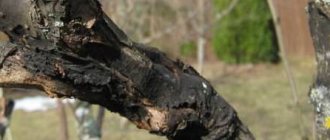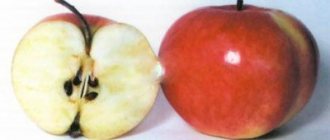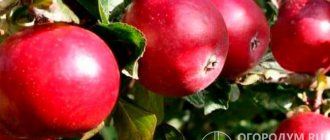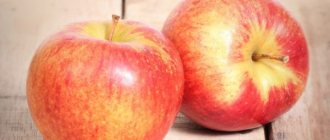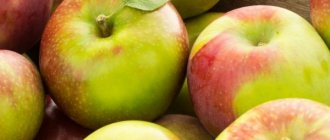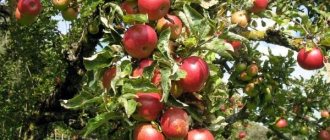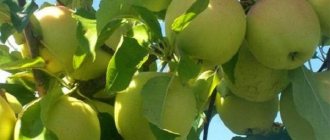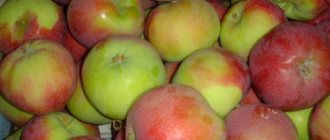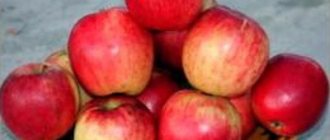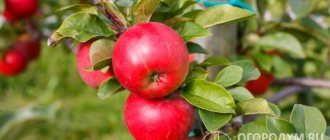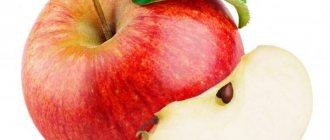Sinap Orlovsky is famous for its interesting and rich taste and pleasant aroma, as well as the long shelf life of its fruits, due to which many gardeners grow this variety on their site. It is very important to properly care for the plant so that it produces a bountiful and stable harvest.
History of the variety's creation
The history of the development of the Sinap Orlovsky variety is quite interesting, since it includes several stages. In the 20s of the last century, Isaev received the Northern Sinap variety, after which, in 1955, he began breeding a new variety, namely Orlovsky, crossing the northern variety and the Pamyat Michurin variety. Since that moment, the apple tree has gained great popularity among gardeners and has been cultivated in Russia for a very long time.
Northern Sinap
History of variety selection
The variety was obtained in the mid-50s of the last century on the basis of the All-Russian Research Institute of Horticulture named after. I.V. Michurin by a group of Soviet breeders (T.A. Trofimova, E.N. Sedov, N.G. Krasova, V.K. Zaets) as a result of hybrid crossing of the popular apple trees “Northern Sinap” and “Memory of Michurin”.
In the photo are the apple trees “Northern Sinap” (left) and “Pamyat Michurin” (right), which served as the initial forms for breeding the hybrid variety
In 1979, state variety trials of the plant began in experimental plantings of the USSR. Ten years later, “Sinap Orlovsky” was officially registered in the State Register of the Russian Federation as zoned and recommended for cultivation in the North-Western, Central, Central Black Earth and Middle Volga regions, and in 1998 it was patented by the originators.
The trees' stable yield and frost resistance, excellent taste and long-lasting shelf life of large fruits have made this apple tree a favorite of domestic gardeners, and also ensured its great popularity in Belarus and other post-Soviet countries.
Main characteristics
Trees of the Sinap Orlovsky variety usually reach more than 7 meters, while the crown is very wide, but not dense. The skeletal branches are sparse, thick, and extend from the tree at right angles. Young shoots are of moderate thickness and have fluff.
The foliage is distinguished by its sparse arrangement and obovate shape, it is large and wide, and has a dark green tint. The surface is either flat or slightly convex. The edge of the leaf is serrated, crenate or wavy.
The flowers are always large and painted white and pink. Fruiting is mixed: the ovary occurs on ringlets, long and short fruiting rods.
Since adult individuals are massive, they need to be planted at a sufficiently large distance, otherwise the shade will negatively affect the quantity of the harvest and its taste.
The apple tree is considered high-yielding.
Apple tree variety Sinap Orlovsky
Sinap Orlovsky is a late-winter apple tree variety obtained in 1955 at the All-Russian Research Institute for Breeding Fruit Crops and the All-Union Research Institute of Horticulture named after. I.V. Michurina as a result of crossing two well-known varietal apple trees - Northern Sinap and Memory of Michurin. The authors of this variety are domestic breeders: Sedov E.N., Trofimova T.A., Zaets V.K. and Krasova N.G.
Sinap Orlovsky was accepted for State testing in 1979, and 10 years later it was zoned in the Central, Central Black Earth, Middle Volga and North-Western regions of our country, as well as in six regions of Belarus. The apple tree is most widespread in central Russia, not only in private gardens, but also in industrial gardens.
Trees of this variety are large in size, so when planting a site for them, you need to allocate quite a lot of free space. Apple trees have a wide crown and fairly massive spreading branches. Due to the sparse arrangement of the main branches, the crown does not become too dense, which undoubtedly makes it easier to care for the tree and contributes to the collection of a high-quality harvest. However, trees require periodic pruning and shaping. This apple tree is characterized by the main branches extending from the trunk at right angles, with the ends of the branches directed upward. The surface of the bark on the trunk and skeletal branches is rough and gray.
The shoots are dark brown, of medium thickness, heavily pubescent, geniculate, with sparsely spaced leaves, faceted in cross-section. There are few lentils and they are small in size. The buds are large, pubescent, appressed, and have a conical shape. Sinap Orlovsky is characterized by a mixed type of fruiting: on simple and complex ringlets, short and long fruiting twigs. The leaves are large, wide, dark green in color, pubescent, obovate, almost flat, with a pointed, broadly wedge-shaped base. The surface of the leaves can be flat or convex. The leaf is wavy along the edge, serrate-crenate, and crenate at the base. The tips of the leaves are twisted, the edges are raised. The petioles are short, the stipules are large, lanceolate, approximately the same length as the petioles. A significant part of the leaves on the shoot are drooping, extending at an obtuse angle to the shoot.
In spring, trees of this variety become the main decoration of the garden thanks to their large flowers of a delicate light pink color. The buds have a white-pink tint, the petals are closed, the stigma of the pistil is often located below the anthers, much less often - at the same level with them.
The fruits of the Sinap Orlovsky apple tree mostly grow quite large in size or are clearly larger than average (the average weight of one apple is 150 grams). All apples are the same size, round-conical oblong in shape, with a slightly beveled top and blunt ribs. The skin of the fruit is dense, the surface is glossy, smooth, with a slight oily tint. You can easily see large white subcutaneous dots on the apple peel. During the picking period, the main color of the fruit is yellowish-green; after short storage it becomes golden-yellow. The outer color of apples is noticeable only from their sunny side in the form of a delicate, blurred blush. The funnel has a narrow, pointed shape, no rustiness. The stalk can be short or medium length. The fruits have a deep saucer bordered with rather large ribs. In most cases, the calyx of apples is closed, but in large fruits it can be open or semi-open. The heart is poorly expressed. Seed chambers can be slightly open or closed. The seeds are brown in color, small, pointed, ribbed. The subcup tube is small, conical in shape.
The pulp of apples has excellent taste due to the harmonious combination of sourness and sweetness, juiciness and a subtle, pleasant aroma. The structure of the pulp is loose, prone to splitting, greenish-cream in color. The average long-term assessment of the taste of fruits on a tasting scale is 4.4 - 4.7 points. The apples' appearance score is 4.3 points. According to the chemical composition, the fruits contain: sugars (9.5%), titratable acid (0.52%), pectin substances (8.9%), ascorbic acid (13.7 mg/100 g), P-active substances (194 mg/100 g).
The period of removable fruit ripeness in the middle zone occurs in the last days of September. The storage capacity of apples of this variety is very high; the fruits are stored until the end of spring. This quality is very attractive for commercial cultivation: apples are used by manufacturers of baby food and juices.
Sinap Orlovsky trees have high rates of winter hardiness and early fruiting. Average resistance to scab was noted. Young trees grow quite actively, fruiting begins at 4-5 years. Unlike Antonovka, trees of this variety consistently bear fruit every year, not only young apple trees, but also mature ones. According to VNIISPK, up to 170 centners of harvest can be obtained from 1 hectare of garden. The best pollinators for this variety are Antonovka vulgaris and Welsey.
The obvious advantages of the Sinap Orlovsky apple tree are high consumer and commercial qualities of apples, early fruiting, long-term storage of fruits unharmed, and a good level of winter hardiness.
The main disadvantage is the large size of the trees.
Despite the ease of care, it is advisable to select fertile soil for planting Sinap Orlovsky. With a low level of calcium in the soil, the fruits are affected by diseases and the taste of apples becomes not entirely pleasant (bitter pitting appears).
Description of fruits
The fruits of this apple tree are oblong, have a round-conical shape and noticeable ribs. The peel is dense and shiny, smooth and slightly oily to the touch. The main color when harvesting is yellow-green, and if the apple is allowed to ripen, it will turn golden. Apples may have a reddish blush, which is expressed slightly and mainly on the sunny side. The average weight of the fetus is 150 grams, but it can be more or less. The seeds are small and brown.
The pulp is incredibly juicy and has a green-cream color. The taste is sour with sweet notes, not sharp and harmonious. It is worth noting that the harvest tastes best only after storage; it is best to take a sample in November. If you try an apple freshly picked from the tree, it will most likely not taste good.
The amount of sugars in the fruit is about 9.5%, titratable acids – 0.5%, ascorbic acid 13.7 mg per 100 g, pectins – 8.9%.
With proper organization of conditions in the storage room, the harvest can be stored until May.
Cultivation in the Moscow region and Volga region
The Sinap Orlovsky apple tree is excellent for climatic conditions in the Middle Volga and Central regions. The ripening of the crop in these regions begins a little earlier than in the West Siberian District.
During particularly cold winter seasons, the upper parts of young apple trees can freeze if care is not taken to protect them.
Where to buy planting material?
It is recommended to buy Sinap Orlovsky apple tree seedlings from trusted nurseries located in the region of future cultivation. Especially planting material that was germinated until three or four years of age. It is difficult for them to adapt to new conditions, especially frostier ones.
For a normal harvest process, buy planting materials only from trusted stores.
It is possible to buy an apple tree from private summer residents who cultivate apple trees for industrial purposes. However, the seller may not always be honest with you.
Note! Purchasing a fruit tree through social networks is also not always a good decision, since even healthy planting material can be damaged during transportation.
Pollinator trees
For a normal harvest, the Sinap Orlovsky apple tree needs other varieties planted nearby. The best options are:
- Welsey;
- Antonovka.
Welsey
Antonovka
How to properly carry out the pruning procedure
Pruning of the Sinap Orlovsky apple tree is carried out in the spring, before the start of sap flow, or in the autumn - after the end of leaf fall, but about a couple of weeks before the onset of cold weather, so that the tree has time to get stronger after this procedure.
In the summer, only shoots that are heavily affected by the disease can be pruned; the cut areas must be covered with garden varnish.
Trimming
In the spring and autumn, be sure to cut out all the tops - shoots growing vertically upward, as well as broken, dry and frozen branches.
Interesting!
Pruning an apple tree in the fall: rules and timing of the procedure
Productivity
Fruiting can be expected 4 or 5 years after planting a young plant. On a dwarf rootstock it can be expected earlier. It usually occurs every year, but there may also be weak periodicity.
In general, you can collect about 170 centners of apples per hectare (up to 200 kilograms per individual), which may seem like a very modest figure to many. Gradually, this indicator increases, especially if you properly care for the plant.
It is worth remembering that if a tree bears too many fruits, this will negatively affect their size and taste. Ripening occurs mainly in mid-autumn. In the absence of a good pollinator, these figures may be 40% less.
Yield Characteristics
This tree can be early ripening if the variety is grafted onto an appropriate rootstock. In this case, fruiting can occur as early as 4-5 seasons from the moment of grafting onto the rootstock. It is noted that it is stable and annual at any age, including on old apple trees.
In the first years, fruiting is not particularly abundant, but at least 135-165 kg of ripe apple fruits are usually collected from an adult tree if the tree is well cared for.
Good varieties of apples:
Apple Melba Moscow Grushovka Amber Necklace
Diseases and pests
This variety is not immune to scab or powdery mildew, so it often suffers from them. Powdery mildew manifests itself in the form of a white coating on the foliage; at the first sign, you need to immediately take action, otherwise you can destroy the apple tree.
To combat the disease, colloidal sulfur or preparations with a high copper content are used. It is very important to get rid of all affected parts of the plant, and treat the wounds with chalk for young trees or limestone solution for adults.
Scab is typical for conditions of high humidity or stagnation of air in the roots. First it is noticeable on the leaves, and then on the fruits. These are green-brown spots that gradually spread at an ever-increasing speed. To combat infection, it is necessary to disinfect and fertilize the soil, and also protect the apple tree from high humidity.
Sometimes the tree is subject to bitter pitting, which is also characteristic of high humidity, incorrect harvesting times and improper storage of fruits. The disease also occurs when there is a high nitrogen content in the soil. The pitting manifests itself as characteristic brown depressions. To avoid illness, it is recommended to spray with calcium chloride, and also to collect apples in a timely manner and store them under suitable conditions.
Powdery mildew
Scab
Bitter pitting
As for pests, everything is standard here: the apple moth is the most frequent guest. To combat this parasite, insecticides are used according to the instructions.
Features of the tree depending on the rootstock
The height of the fruit crop, resistance to pests and frost, and the dessert qualities of the fruit depend on the rootstock. Seedlings are often grafted onto a dwarf rootstock. Medium-dwarf and vigorous-growing varieties can also be used.
If a late-ripening garden crop is grafted onto a vigorous young apple tree, the height of the tree will reach 6-7 m. Thanks to the powerful and well-developed root system, the seedling of the hybrid variety will be resistant to drought. A large tree lives 45-50 years.
Be prepared that you will have to wait a long time for the harvest. “Giant” will delight you with fruits in the 6th year after planting. Another disadvantage of a tall apple tree is its small fruits.
In industrial gardens you can often see specimens grafted onto semi-dwarf rootstocks. A medium-sized apple tree lives on average 40 years. The tree is resistant to pests. It is not difficult to harvest from the branches of the pome crop. The only caveat: fruits may differ in size from each other.
If you are the owner of a small summer cottage, purchase a seedling on a dwarf rootstock. The compact hybrid tolerates proximity to groundwater better than its tall “brothers”. This happens because small trees have a shallow root system.
A specimen grown on a dwarf rootstock produces large fruits. The only nuance that may upset you: a low-growing apple tree lives less (20-25 years).
Advantages and disadvantages
Before planting, any gardener should become familiar with the advantages and disadvantages of the variety. Sinap Orlovsky is characterized by the following positive features:
- Precociousness. Basically, the harvest begins 4-5 years after planting the seedling.
- Good yield indicators. Already from young individuals up to 200 kilograms of apples are harvested.
- Long shelf life of fruits. They can be stored almost until the end of spring.
- When frozen, apples do not freeze out, retaining their taste and product characteristics.
- The taste of the fruit is generally not bad, and it does not deteriorate even with long-term storage, but only becomes even better.
- The variety is not afraid of frost, so it can be planted without fear in regions with not the best climate.
Of course, this apple tree is not without its negative aspects. They are as follows:
- The huge size of the trees and spreading crown, which creates problems with harvesting.
- Without pollinators, fruiting is extremely low, for this reason the plant needs pollinators.
- The apple tree is afraid of scab and codling moth, so it needs to be treated regularly. In addition, if you make mistakes in care, you may encounter bitter pitting.
- For stable fruiting and normal development, you need to organize systematic care of the plant.
Other varieties of the variety
In addition to Oryol and Severny, there are other varieties of Sinap that are also worth paying attention to.
Qandil
Sinap Kandil apples of autumn ripening. Harvesting occurs at the end of August - beginning of September. Fruits weighing up to 140 g, elongated in shape. The surface is smooth, yellow-green in color with a slight blush. The pulp is juicy and sweet. Trees are resistant to common diseases. In adulthood, fruiting is abundant, from 200 to 300 kg per tree.
The fruits of the Sinap Kandil variety are elongated and cylindrical in shape with a smooth surface
Mountain
Mountain Sinap is early-bearing and is considered late-autumn. Moderately resistant to frost, rarely affected by scab. The weight of the fruit ranges from 180 to 300 g. The shape of the apples is round, the color of the skin is golden with a pink tint on one side. The pulp is sweet and juicy. The shelf life of the fruit is 5–6 months.
The fruits of Mountain Sinap have an attractive appearance and delicate aroma
Video: apple tree variety Mountain Sinap
Heroic
Vigorous, frost-resistant, high-yielding version of Sinap. Resistance to powdery mildew and scab is average. The weight of the fruits is from 130 to 200 g, they have good taste and presentation. The apples are white-green with a slight blush. The harvest takes place at the end of September. Under the right conditions, apples can be stored until April.
Apples of the Bogatyrsky Sinap variety are stored for up to 7 months and are characterized by good transportability
Belorussian
This is a vigorous, early-fruiting variety of the Sinap variety. Frost resistance is high; it is extremely rarely affected by scab. Mature trees have a dense, wide-pyramidal crown. The weight of apples is from 90 to 120 g, the skin is dense, yellowish-green in color with a pink blush. The pulp of the fruit is juicy, sour, greenish-white in color. Apples ripen at the end of September. When stored in the refrigerator, they do not lose commercial quality until May - June.
Belorussian Sinap is a fast-growing, productive, scab-resistant variety
Sary Sinap (Crimean Sinap)
Late winter option, resistant to scab and powdery mildew. The tree is medium-sized. The fruits are small (up to 120 g), with smooth yellow-green skin and a pink blush. The pulp is white, juicy, with a sweet and sour taste and dense consistency. The harvest is stored until April-May.
The fruits of the Sary Sinap variety acquire an appetizing blush on the sunny side
Almaty
An autumn-ripening variety of Sinap, resistant to scab and powdery mildew. The tree is medium-sized, with dark pink flowers during the flowering period. Fruit weight is from 110 to 150 g. The color of apples before ripening is yellow-green, and when ripe it becomes dark red. The pulp is white, sweet and juicy, the consistency is tender and loose. Harvesting occurs in the third ten days of September.
The fruits of Almaty Sinap are large, oval-shaped, with shiny skin
Khakassian
Khakass Sinap was obtained by crossing the varieties Northern Sinap and Rossoshanskoye Polosatoe. An adult tree has a height of 4–4.5 m. The crown is narrow pyramidal, the branches are directed upward. The weight of the harvest from one tree is 50–60 kg. The variety is resistant to frost and drought. The fruits are oval, yellow-green in color with crimson streaks. The pulp is dense and sweet. The average weight of an apple is 170 g. When ripening, the apples do not crumble. In suitable conditions they remain until May.
Khakass Sinap is resistant to frost, winter drying and damping off
Video: apple tree variety Khakass Sinap
Minusinsky
This is a medium-sized tree with autumn ripening. Minusinsk Sinap begins to bear fruit 5 years after planting. The average fruit weight is 40–50 g. The skin is yellow-green with a blurry pink-purple tint. The pulp is sweet and juicy, the consistency is loose. The variety is frost-resistant and is rarely affected by scab.
The fruits of Minusinsky Sinapa are one-dimensional, yellow-green in color with a blurred purple blush over the entire surface
Sinap on a dwarf rootstock
Sinap on a dwarf rootstock is distinguished by the fact that the height of an adult tree is a maximum of 3 m, and fruiting begins 2–3 years after planting. Thanks to its compact size, it takes up less space in garden plots, which allows you to reduce the distance between seedlings when planting to 2 m from each other.
Sinap on a dwarf rootstock bears fruit 2-3 years after planting
Video: Northern Sinap on a dwarf rootstock
The variety of Sinapa varieties, due to their unique taste, excellent consumer appearance and long-term storage of fruits, will allow you to choose a variety according to your individual preferences. Unpretentious living conditions, resistance to frost and common diseases, early fruiting and high yield of varieties will be appreciated by gardeners.
- Author: Ekaterina Krushina
I love nature and the world around us. I love spending time at my dacha. Copywriting is not a job for me, but rather a lifestyle. Rate this article:
- 5
- 4
- 3
- 2
- 1
(9 votes, average: 4.9 out of 5)
Share with your friends!
Landing
Planting is best done either at the end of April or at the end of September, and the latter option is recommended. Some planting tips:
- You need to buy young plants with good roots and not transport them from one climate to another.
- It is advisable to plant the tree in a sunny area that is well drained.
- Loamy soil is best suited, on which the apple tree will produce the largest harvest.
- Trees are placed at a distance of 4-5 meters from each other.
- The pit is prepared a month before planting, forming a hole measuring 1.5 * 1.5 * 1.2 meters.
The top layer of dug up soil is mixed with the bottom, adding the following fertilizers: 20 kilograms of humus (manure), 250 grams of wood ash and superphosphate, 100 grams of potassium sulfate and 150 grams of calcium nitrate.
The hole is filled two-thirds with a mixture of soil and fertilizers. The top is sprinkled with fertile soil without fertilizers, after which it is watered well and the fertile soil is covered again. For the first two years, a wooden peg should be driven in.
Landing Features
The area for planting this variety should be well illuminated by sunlight and also be protected from strong gusts of cold wind. The apple tree prefers loose and fertile soil, which allows moisture and air to pass well to the roots. Since the trees grow tall with a large oval crown, a distance of at least 3.5-4 m must be left between the seedlings so that they do not interfere with each other during the growth process.
In the fall, it is better to plant 3-year-old Sinap Orlovsky apple tree seedlings on the site, which take longer to take root on the site, but tolerate winter cold well. It is better to plant trees from the last ten days of September to the second ten days of October
.
And in the spring it is better to plant two-year-old trees of the Oryol Sinap, which acclimatize well in a new place, grow quickly and, before the onset of frost, manage to become so strong that they do not freeze out during the winter cold period. Planting is carried out after the earth has warmed up sufficiently, usually from the second ten days of April to the second ten days of May. The main thing is to have time to plant before the sap begins to flow.
At least one pollinator tree should be immediately planted next to the Oryol Sinap so that the variety’s yield will be high in the future.
Basic rules for planting Oryol Sinap seedlings on a garden plot:
- the grafting site cannot be buried in the ground - it should be 6-8 cm above the soil level;
- when planting, a peg is driven into the hole, which should rise 0.6-0.8 m above the ground. The seedling will be tied to this support for better acclimatization;
- Only rotted manure is placed in the planting hole, since fresh manure will certainly burn the tender roots of the tree. Fresh mullein can be used as mulch in the trunk circle of an apple tree;
- if trees are planted in the autumn, they must be covered with light non-woven fabric for the winter;
- if the soil on the site is heavy and too enriched with fertilizers, then sand must be added to it to increase the air permeability of the soil. Chernozem and clay must be added to sandy soil.
How to plant apple tree seedlings correctly - video
Care
Although the variety is generally unpretentious, it still needs careful care. It is very important to organize watering correctly. In summer and spring, watering is required every week - 3 buckets of water per tree. To ensure uniform distribution of water, the soil is loosened well after these activities.
If possible, it is necessary to prevent the plant from forming fruits during the first five years; to do this, all or most of the flowers are torn off.
In the first year, in April, the apple tree is treated for pests, and this is done twice: when the buds begin to swell and before the buds bloom.
Peculiarities of fruiting and ripening time
Fruiting begins from the 4-5th year of the apple tree’s life. Yield stability is maintained for up to 3 years, after which activity decreases, but is replenished with properly organized fertilizing.
To avoid intensive growth of green mass without the formation of fruits, you should not allow an excess of nitrogen-containing fertilizers.
With a large number of ovaries, the size of the apples decreases and the taste quality decreases, therefore it is recommended to leave not all the buds on the shoots, removing 1/3 of them.
Feeding
In addition to systematic watering, Sinap Orlovsky needs fertilizers. They are applied 4 times per season:
- after winter, when the tree begins to wake up;
- after bud formation;
- after flowering, during the formation of ovaries;
- in the fall, after harvesting.
Superphosphate
Manure
Urea (urea)
Since fertilizers are already applied during planting, they begin to be applied again in the second season. In the spring, a kilogram of manure mixed with a bucket of soil is used.
When the buds appear, apply 500 grams of urea, scattering it around the tree trunk and loosening it.
After flowering, mix 100 grams of superphosphate, 40 grams of calcium and 60 grams of urea with 10 liters of water and water the apple tree with this solution.
After harvesting, to restore strength, the apple tree is watered with a solution of 10 liters of water and 50 grams of superphosphate.
Tree feeding
The main feature of the Orlovsky Sinap variety is its high need for calcium, which the tree can only obtain from the soil.
. The lack of this mineral reduces the yield of the apple tree, the foliage darkens, acquires a bluish tint, and begins to curl.
Fertilizing the apple tree in spring
Autumn feeding of fruit trees - video
Important!
Heavy soils contain much more calcium than loamy or sandy soils.
To ensure there is enough calcium in the soil, the following fertilizers should be applied to the tree trunks:
- chalk;
- dolomite flour;
- slaked lime;
- crushed eggshells.
Reviews
Natalya, Yegoryevsk : I really like the Sinap Orlovsky variety of apples, I already have several trees growing on my plot. The only caveat is that the apple trees are really huge, and it can be difficult to harvest from them, especially when there is a lot of it. Fruiting is stable every year, no frequency. I want to give one little piece of advice to gardeners: let the apples sit for a while, and then just try. If you eat freshly picked fruits, you may be disappointed.
Oleg, Orenburg : Many years ago, my wife and I planted several Sinap trees, and since then we have been collecting several buckets of harvest each time. Everyone likes it: adults, children, neighbors. The taste is unusual, sour, but with pleasant notes of sweetness. The harvested crop is stored quietly until spring, the main thing is to organize the conditions correctly. Over time, apples only become tastier. That's why I like this variety so much.
Reviews from gardeners
Elena T, 37 years old, Moscow. “Orlovsky Sinap is the latest apple tree in our garden. We harvest in early October before the first frost and immediately put it into storage. Freshly picked apples are sour and tough, but when they sit for a couple of months, they become much tastier! As they explained to me, all late varieties are like this: they ripen during storage. We eat them until April and are very happy about it. I grow without chemicals and fertilizers, so that they have only one benefit...”
Vasily Ivanovich, Nizhny Novgorod. ‟ I have two Sinaps: Oryol and Northern. I grafted them myself onto seedlings grown from seeds, and took the scion from a neighbor. The Orlovsky one is tastier, and the apple is larger. But I don’t like that the trees have grown huge. They take up more than a hundred square meters of land, and they don’t dare cut too much. But I pulled a hammock between them, the branches are thick, the trunk is strong - they can withstand it.”
Tatiana. Saratov. ‟ In our city, Sinap is sold by the Volga Gardens, they sell them from gazelles all winter. It is unlikely that they would plant bad varieties. The apples are juicy, a little sour, so we decided to plant these at the dacha.”
Disease susceptibility
Sinap Orlovsky exhibits average resistance to scab and powdery mildew.
Scab is treated with fungicides.
Copper sulfate helps against powdery mildew.
To prevent infection, it is necessary to carry out preventive garden treatments:
- monitor the condition of the branches ; broken and damaged ones must be removed with garden tools (secateurs, saw). The pruning areas are treated with lime solution;
- inspect the integrity of the cortex . In case of damage, clean up is carried out, and the wounds are sealed with garden pitch;
- Spraying is carried out in the fall, after harvesting . For treatment, use a 3% solution of copper sulfate ;
- in early spring (before buds open), preventive treatment is carried out with Bordeaux mixture .
To replenish calcium in the soil, use the liquid preparation Kalbit S. It improves the structure of fruits and eliminates problems such as bitter pitting, which occurs when there is a lack of calcium in the soil. Increases the keeping quality and transportability of fruits.
Spray the foliage in the evening. For 10 liters of water use 10–20 ml of the drug. It is not recommended to combine the product with the use of drugs containing sulfur and phosphorus.
Read more about apple tree diseases in the material: “Treating diseases in apple trees - when and how to treat apple trees.”
Rules for planting seedlings
The suitable time for planting apple tree seedlings of the Sinap Northern and Orlovsky varieties is the period from mid-September to mid-October.
Seedlings can be planted in spring. If the apple tree is planted in the spring, then planting should begin in the first half of April. In the spring it is worth planting when the threat of frost has completely passed, otherwise the seedlings may not take root.
During planting, it is worth considering the future large size of the trees, so when planting seedlings, leave a distance of 5-7 cm between them.
Main landing features:
- Holes for seedlings must be made 14 days in advance for planting;
- The depth of the holes must be at least 80 cm, and the length and width of each hole must be at least 1 meter;
- The bottom of the hole should be loosened with a rake;
- Then you need to break the brick or expanded clay into small fragments and place it on the bottom of the hole. This will provide additional drainage;
- The fertile soil in the hole is mixed with rotted manure and wood ash. ¾ of the land will require ¼ of the fertilizer mixture;
- Then you need to add 40 grams of potassium sulfate and 80 grams of superphosphate to the finished mixture of soil and fertilizer mixture. Everything is mixed thoroughly;
- After this, this mixture must be poured into the planting hole. The fertilizer should fill the hole by almost 1/3;
- After pouring the fertilizer, you need to add a little earth to the central part to form a hill 20 cm high;
Before planting a seedling in a hole, it is necessary to inspect its roots. It is advisable to remove all dry and damaged roots. It is placed in water for 4-5 hours so that the roots are saturated with moisture. This will speed up the growth and survival of the tree.
- After this, the seedling is placed in the hole. In this case, the distance of the root collar to the ground should be at least 5-6 cm;
- We drive a peg near the seedling; its height should be 60-80 cm. The seedling is tied to this peg;
- The roots are carefully straightened, they should not be tangled. Then they are sprinkled with earth, compacted, but not too much;
- Then the seedling is filled with water. One young tree will require up to 3-4 buckets of water.
Northern Sinap, ready for storage for the winter
It is advisable to plant young planting material of apple trees of the Sinap Northern and Orlovsky varieties on loamy, sandy loam soils with high air and moisture permeability . The main indicator is that the planting distance from the flow of groundwater is at least 2 meters, because apple trees cannot tolerate prolonged stagnation of water.
The soil that is used for planting apple trees must have the required calcium content. A lack of calcium can negatively affect the taste of ripened fruits.
List of pollinating trees
Apple trees of this variety are partially self-fertile.
The flowers of the variety are large, colored light pink.
To increase yield levels, planting pollinator trees is recommended. The best pollinators, which bloom at the same time as Sinap Orlovsky, are considered to be Welsey and Antonovka.
It is not necessary to have them on your own site. It is enough that this variety grows in one of the neighbors in the country.
Harm and contraindications
Even though apples are considered a virtually hypoallergenic food and can be consumed by a large number of people, they can be harmful and can aggravate existing health problems in certain types of people. For example, a diet based on apples alone is very popular.
Of course, starting such a diet without consulting a doctor is not recommended. An independent decision to go on an apple diet can lead to poor health. In the absence of normal nutrition, apples can provoke gastrointestinal problems, aggravate colitis, aggravate gastritis or ulcers. Apples should also not be consumed by those who are allergic to them.
